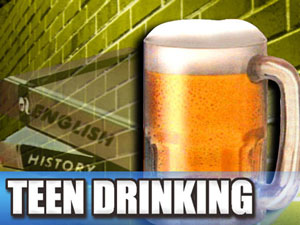Malt Liquor Marketing to Latinos (metroactive, 10-1997)

(FinalCall.com) – The Center on Alcohol Marketing and Youth at Georgetown University found Black youth ages 12 to 20 drink far less alcohol than their White counterparts, but with age they suffer more from alcohol-related diseases than Whites and other ethnicities.
Alcohol-related ailments include heart disease, high blood pressure, decreased or impaired brain functions, liver and kidney damage and kidney failure.
During its study of exposure between 2003 and 2004, the center also found alcohol use contributes to homicides, unintentional injuries and suicide, which are considered the three leading causes of death among Blacks of that age group.
According to the center, 19 percent of the Black youth used alcohol within 30 days prior to the survey, compared to about 33 percent of Whites. Further, Black youth reported “binge” drinking at 10 percent, compared to Whites at 23 percent. Binge drinking is considered as five or more drinks at one sitting, and is associated with health, social and economic problems, and is harmful for adolescent development.
Critics say alcohol is made appealing to Black youth via a consistent, aggressive advertising campaign in magazines, music and videos, and on TV, radio, billboards.
The Archives of Pediatrics & Adolescent Medicine studied Billboard magazine’s 279 most popular songs of 2005 to analyze substance use in popular music. It found rap music referenced alcohol 33 percent of the time, followed by country music at 20 percent. R&B referenced alcohol 7 percent of the time.
Researchers provided a breakdown of alcohol advertisements Black youth were exposed to:
Magazines
– Twelve-to-20-year-olds saw 15 percent more for beer and 10 percent more for distilled spirits per capita than adults age 21 and over; and generally, Black youth saw more advertising for both products than youth in general.
– In national magazines, Black youth saw 34 percent more alcohol advertising than youth in general, 21 percent more for beer and ale, 42 percent more for distilled spirits; and
– 99 percent of Black youth saw an average of 150 alcohol ads in national magazines while 97 percent of all youth saw an average of 113 alcohol ads.
– 14 magazines (including Sports Illustrated, Vibe, Stuff, Entertainment Weekly, the Source, InStyle and Vogue), accounted for 75 percent of Black youth’s exposure in 2004.
Radio
– Of a sample of more than 67,000 occurrences of advertising airing in 104 markets for the 25 top alcohol brands in June-July, 2004, Black youth heard 15 percent more advertising per capita than youth in general;
– In New York, Los Angeles, Chicago, Dallas-Forth Worth, Houston-Galveston and Detroit (six of the top 10 markets comprising 34 percent of America’s Black population), and in 25 of 104 markets, Black youth heard more alcohol advertising on the radio per capita than youth in general)
– Colt 45 Malt Liquor accounted for nearly one-third of Black youth exposure to radio advertising and along with Hennesey Cognac, which most disproportionately exposed Black youth compared to all youth.
TV
– 72 percent of alcohol advertising spending on Black Entertainment Television (BET) targeted 10 programs more likely to be seen by youth;
– Advertisers spent approximately $4.8 million to place ads on all 15 programs most popular with Black youth.
Eddie Mclay, director of information for the National Council on Alcoholism and Other Drug Addictions–Bay Area, told The Final Call the battle to end underage drinking means targeting alcohol companies and distributors, which are both well-rooted in America’s political arena. Liquor stores, restaurants and bars must be held accountable for their roles in youth drinking, he said.
A majority of the ads, especially those during sporting events, target young adults ages 18-24, use sex as an angle, and promote binge drinking, said Mr. Mclay.
Part of National Council on Alcoholism’s work is to implore adults not to buy alcohol for their children, nieces, nephews, cousins or neighbors, he continued. While the council still uses education as a method of prevention, it has gained more success through “environmental prevention,” which is campaigning for liquor stores to place advertisements on doors, windows and walls over five feet high and out of face view of children.
“You can educate the kids but if they are still seeing these advertisements as the cool way of being, it’s easier for them to blow off adults and say ‘it’s my life.’ But if they don’t have this stuff in their face all the time then it’s less likely they’d go ahead and do it,” Mr. Mclay added.
Last March, Kenneth Moritsugu, then-acting U.S. Surgeon General, issued a Call to Action to Prevent and Reduce the enduring national problem of underage drinking, primarily because of the potential long-term negative impact to the adolescent brain.












